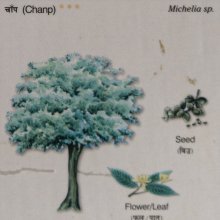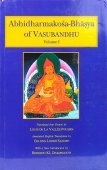Chap, Chāp: 4 definitions
Introduction:
Chap means something in Hinduism, Sanskrit, Hindi, biology. If you want to know the exact meaning, history, etymology or English translation of this term then check out the descriptions on this page. Add your comment or reference to a book if you want to contribute to this summary article.
Alternative spellings of this word include Chhap.
Ambiguity: Although Chap has separate glossary definitions below, it also represents an alternative spelling of the word Cap. It further has the optional forms Chāp.
Images (photo gallery)
Biology (plants and animals)
Source: Google Books: CRC World Dictionary (Regional names)1) Chap in India is the name of a plant defined with Aquilaria agallocha in various botanical sources. This page contains potential references in Ayurveda, modern medicine, and other folk traditions or local practices It has the synonym Aloexylum agallochum Lour. (among others).
2) Chap is also identified with Terminalia catappa It has the synonym Badamia commersonii Gaertn. (etc.).
Example references for further research on medicinal uses or toxicity (see latin names for full list):
· Flora de Filipinas (1837)
· Prodr. (Swartz) (1788)
· Species Plantarum, ed. 4 (1806)
· Prodr. (DC.) (1828)
· Contr. Queensland Herb. (1977)
· Hortus Bengalensis, or ‘a Catalogue of the Plants Growing in the Hounourable East India Company's Botanical Garden at Calcutta’ (1814)
If you are looking for specific details regarding Chap, for example chemical composition, extract dosage, diet and recipes, side effects, health benefits, pregnancy safety, have a look at these references.

This sections includes definitions from the five kingdoms of living things: Animals, Plants, Fungi, Protists and Monera. It will include both the official binomial nomenclature (scientific names usually in Latin) as well as regional spellings and variants.
Languages of India and abroad
Sanskrit dictionary
Source: Cologne Digital Sanskrit Dictionaries: Shabda-Sagara Sanskrit-English DictionaryChap (छप्).—[(i) chapi] r. 1st and 10th cls. (champati champayati-te) To go or. move. cuubha-pakṣe bhvā-pa-saka-seṭ .
Source: Cologne Digital Sanskrit Dictionaries: Yates Sanskrit-English DictionaryChap (छप्):—(ki, i) champati, yati 1. 10. a. To go.
Sanskrit, also spelled संस्कृतम् (saṃskṛtam), is an ancient language of India commonly seen as the grandmother of the Indo-European language family (even English!). Closely allied with Prakrit and Pali, Sanskrit is more exhaustive in both grammar and terms and has the most extensive collection of literature in the world, greatly surpassing its sister-languages Greek and Latin.
Hindi dictionary
Source: DDSA: A practical Hindi-English dictionaryChap in Hindi refers in English to:—(nf) are; pressure; a bow; (foot) sound/blow..—chap (चाप) is alternatively transliterated as Cāpa.
...
See also (Relevant definitions)
Starts with (+320): Capa, Capa-vanpulu, Capacaratti, Capacu, Capai, Capaikkaran, Capaikkattu, Capaikkolai, Capaikkuppurattakku, Capaippirivinai, Capaiyeru, Capaiyiruttu, Capaiyolukkam, Capaiyullar, Capakakitam, Capakampam, Capakana, Capakariyam, Capakkam, Capakkattotarcci.
Ends with: Chupchap, Ka-chap, Peyincap, Ping chap, Rani-chap, Ucch-raktchaap, Ya son krachap, Yaa son krachap.
Full-text (+291): Bacali, Bacyali, Baceli, Padadari, Becali, Musakata, Padadarika, Murchapagama, Chup-chaap-basnu, Panidakara, Gomajisomaji, Ayabogayabo, Ka-chap, Ping chap, Chap-ta-haza, Chap-alau, Karatin, Kurvati, Musakada, Jabada.
Relevant text
Search found 109 books and stories containing Chap, Chāp, Chaap; (plurals include: Chaps, Chāps, Chaaps). You can also click to the full overview containing English textual excerpts. Below are direct links for the most relevant articles:
Heimskringla (by Snorri Sturlson)
Chapter V - Saga Of King Harald Grafeld
Chapter IV - Hakon The Good's Saga
Part 1 - Harald's Strife With Hake And His Father Gandalf < [Chapter III - Harald Harfager's Saga]
The Literature of the Ancient Egyptians (by E.A. Wallis Budge)
Vinaya (3): The Cullavagga (by T. W. Rhys Davids)
Cullavagga, Khandaka 3, Chapter 33 < [Khandaka 3 - Probation And Penance (B)]
Cullavagga, Khandaka 3, Chapter 30 < [Khandaka 3 - Probation And Penance (B)]
Cullavagga, Khandaka 3, Chapter 23 < [Khandaka 3 - Probation And Penance (B)]
Impact of Vedic Culture on Society (by Kaushik Acharya)
4. Religious Aspect of Dāna < [Chapter 2]
1.C: Dāna in the Mahābhārata and the Bhagavad-gītā < [Chapter 2]
Study of the Contemporary Literary Sources < [Chapter 3]
Gobhila-grihya-sutra (by Hermann Oldenberg)
The Ordeal of Watching a Cricket Match < [April – June, 1990]
Slang < [January – March, 1997]
Triple Stream < [January – March, 2006]
Related products


